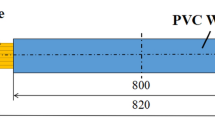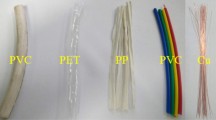Abstract
The electric fires are highly likely caused by the combustible wire insulation material ignited by a short circuiting or overload current in residential and commercial buildings, nuclear power plants, etc. It is important to know fire behaviors of the insulation materials over energized wires under overload currents, so fire behaviors are investigated experimentally over high-current energized polyethylene (PE)-insulated copper wires A and B with different sizes (dc/do = 0.9 mm/3.0 mm and 1.3 mm/4.2 mm for wires A and B, respectively, where dc and do denote the core and outer diameter of wire, respectively). The results show that the flame height rises firstly and then remains steady with the increasing current under low current, which is similar with the previous research, while the flame height drops sharply when the current is extremely high over 40 A. The flame width also drops with current under high-current condition. In addition, the surface temperature of wire, measured by infrared thermography, agrees well with the predicted balance temperature of wire under low current, but deviates from the balance temperature under high currents. Correspondingly, the measured flame spread rate agrees well with the prediction model based on the thermal balance temperature at low currents, while shows an obvious deviation under large currents. The flame spread rate grows approximately with the square of the current, but tends to increase slowly and even remains steady under high current. Moreover, the effects of wire size on flame spread are also investigated. The flame of wire with large diameter is wider, but its flame spread rate is lower and rises slower with current. The results of this work provide important information about fire behaviors over energized wires under overload currents and may guide the design of future electric fire safety.







Similar content being viewed by others
References
Wang Z, Wang J. An experimental study on the fire characteristics of new and aged building wires using a cone calorimeter. J Therm Anal Calorim. 2019;135:3115–222.
Wang Z, Wei R, Ouyang DX, et al. Investigation on thermal stability and flame spread behavior of new and aged fine electrical wires. J Therm Anal Calorim. 2019. https://doi.org/10.1007/s10973-019-08778-5.
USFA. Residential building electrical fires (2009–2011). Top Rep Ser. 2014;14:1–11.
Thomas E. Electric services and building fires. Fire Technol. 1992;28:70–86.
Bakhman NN, Aldabaev LI, Kondrikov BN, et al. Burning of polymeric coatings on copper wires and glass threads: I Flame propagation velocity. Combust Flame. 1981;41:17–34.
Bakhman NN, Aldabaev LI, Kondrikov BN, et al. Burning of polymeric coatings on copper wires and glass threads: II. Critical conditions of burning. Combust Flame. 1981;41:35–433.
Fernandez-Pello AC, Hasegawa HK, Staggs K, et al. A study of the fire performance of electrical cables. Fire Saf Sci. 1991;3:237–47.
Greenberg PS, Sacksteder KR, Kashiwagi T. Wire insulation flammability experiment. NASA CP. 1994;3272:631–55.
Takahashi S, Ito H, Nakanura Y, Fujita O. Extinction limits of spreading flames over wires in microgravity. Combust Flame. 2013;160:1900–2.
Fujita O, Nishizawa K, Ito H. Effect of low external flow on flame spread over polyethylene-insulated wire in microgravity. Proc Combust Inst. 2002;29:2545–52.
Kikuchi M, Fujita O, Ito K. Experimental study on flame spread over wire insulation in microgravity. Proc Combust Inst. 1998;27:2507–14.
Nakamura Y, Yoshimura N, Ito H, Azumaya K, Fujita O. Flame spread over electric wire in sub-atmospheric pressure. Proc Combust Inst. 2009;32:2559–666.
Nakamura Y, Yoshimura N, Matsumura T, Ito H, Fujita O. Opposed-wind effect on flame spread of electric wire in sub-atmospheric pressure. J Therm Sci. 2008;3:430–41.
Huang XY, Nakamura Y, Williams FA. Ignition-to-spread transition of externally heated electrical wire. Proc Combust Inst. 2013;34:2505–12.
Hu LH, Zhang YS, Yoshioka K, Izumo H, Fujita O. Flame spread over electric wire with high thermal conductivity metal core at different inclinations. Proc Combust Inst. 2015;35:2607–14.
Kobayashi Y, Huang XY, Nakaya S, et al. Flame spread over horizontal and vertical wires: the role of dripping and core. Fire Saf J. 2017;91:112–22.
Kobayashi Y, Konno Y, Huang XY, et al. Effect of insulation melting and dripping on opposed flame spread over laboratory simulated electrical wires. Fire Saf J. 2018;95:1–10.
Kim M, Chung S, Fujita O. Effect of AC electric fields on flame spread over electrical wire. Proc Combust Inst. 2011;33:1145–51.
Seung J, Sun H, Jeong P, et al. Flame spread over inclined electrical wires with AC electric fields. Combust Flame. 2017;185:82–92.
Takano Y, Fujita O, Shigeta N, et al. Ignition limits of short-term overloaded electric wires in microgravity. Proc Combust Inst. 2013;34:2665–733.
Shimizu K, Kikuchi M, Hashimoto N, Fujita O. A numerical and experimental study of the ignition of insulated electric wire with long-term excess current supply under microgravity. Proc Combust Inst. 2017;36:3063–71.
Wang XW, He H, Zhao LY, et al. Ignition and flame propagation of externally heated electrical wires with electric currents. Fire Technol. 2016;52:533–46.
He H, Zhang QX, Zhao LY, et al. Flame propagation over energized PE-insulated wire under low pressure. Int J Comput Methods Exp Meas. 2017;5:87–95.
He H, Zhang QX, Tu R, et al. Molten thermoplastic dripping behavior induced by flame spread over wire insulation under overload currents. J Hazard Mater. 2016;320:628–34.
Zhang Y, Chen XF, Song YH, et al. The deceleration mechanism and the critical extinction angle of downward flame spread over inclined cellulosic solids. Appl Therm Eng. 2017;124:185–90.
Zhang Y, Tang KX, Liu ZY, et al. Modified carbon-dioxide measurement to predict the heat release rate of fire burning in a compartment based on the three-zone model. Fire Mater. 2019;43:256–65.
Zhang Y, Huang XJ, Ji J, et al. Experimental study on the characteristics of horizontal flame spread over XPS surface on plateau. J Hazard Mater. 2011;189:34–9.
Zhang Y, Sun JH, Huang XJ, et al. Heat transfer mechanisms in horizontal flame spread over wood and extruded polystyrene surfaces. Int J Heat Mass Transf. 2013;61:28–34.
Acknowledgements
The authors gratefully acknowledge the financial supports from the National Natural Science Foundation of China (Nos. 51607078 and 51404178).
Author information
Authors and Affiliations
Corresponding author
Additional information
Publisher's Note
Springer Nature remains neutral with regard to jurisdictional claims in published maps and institutional affiliations.
Rights and permissions
About this article
Cite this article
Zhang, Y., Tang, K., Liu, Z. et al. Experimental study on thermal and fire behaviors of energized PE-insulated wires under overload currents. J Therm Anal Calorim 145, 345–351 (2021). https://doi.org/10.1007/s10973-020-09745-1
Received:
Accepted:
Published:
Issue Date:
DOI: https://doi.org/10.1007/s10973-020-09745-1




